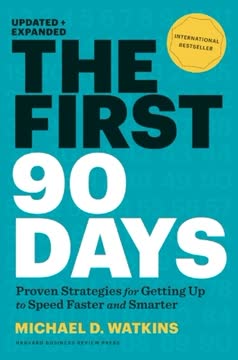Key Takeaways
1. Embrace humility, respect, and trust to foster effective collaboration
HRT: Humility, Respect, and Trust.
Foundation for collaboration. HRT forms the bedrock of successful teamwork in software development. Humility means acknowledging that you're not the center of the universe and being open to self-improvement. Respect involves genuinely caring about your colleagues and appreciating their abilities. Trust means believing in your team members' competence and allowing them to take the lead when appropriate.
Practical application. Implement HRT by:
- Accepting and giving constructive criticism gracefully
- Sharing credit for successes and taking responsibility for failures
- Actively listening to and considering others' ideas and perspectives
- Delegating tasks and trusting team members to deliver
- Admitting mistakes and being willing to learn from them
2. Build a strong team culture through open communication and shared values
Software development is a team sport.
Culture as a foundation. A strong team culture is essential for creating high-performing software development teams. It provides a shared set of values, expectations, and practices that guide behavior and decision-making.
Key elements of strong culture:
- Clear mission statement to align goals and priorities
- Established communication channels (e.g., mailing lists, chat rooms, regular meetings)
- Code review processes to maintain quality and share knowledge
- Documentation of decisions and rationale
- Consensus-based decision-making balanced with efficient conflict resolution
- Streamlined onboarding for new team members
Foster openness. Encourage open communication by creating an environment where team members feel safe sharing ideas, asking questions, and admitting mistakes. This transparency leads to faster problem-solving, increased innovation, and stronger team bonds.
3. Lead by serving your team and empowering individuals
Traditional managers worry about how to get things done, while leaders worry about what things get done…(and trust their team to figure out how to do it).
Servant leadership. Effective leadership in software development focuses on empowering the team rather than micromanaging. A good leader removes obstacles, provides resources, and creates an environment where team members can thrive.
Key leadership practices:
- Set clear goals and expectations
- Provide opportunities for growth and learning
- Offer constructive feedback and recognition
- Shield the team from organizational chaos
- Trust team members to make decisions
- Balance technical and social aspects of team management
Empower individuals. Encourage autonomy, mastery, and purpose to increase intrinsic motivation. Allow team members to take ownership of their work and contribute to decision-making processes. This approach leads to higher job satisfaction, increased productivity, and better retention of top talent.
4. Identify and address toxic behaviors to protect team dynamics
Almost every social conflict can ultimately be traced back to a lack of humility, respect, or trust.
Recognize poisonous behaviors. Toxic team members can undermine productivity, morale, and overall team effectiveness. Common problematic behaviors include:
- Disrespect for others' time and contributions
- Inability to accept consensus or compromise
- Sense of entitlement or constant complaining
- Poor communication skills or unprofessional conduct
- Perfectionism leading to analysis paralysis
Address issues promptly. When toxic behaviors arise, take swift action to address them. Use the following strategies:
- Focus on changing behaviors rather than labeling individuals
- Have private conversations to provide feedback and set expectations
- Redirect energy towards productive tasks when possible
- Look for underlying facts or concerns in complaints
- Know when to cut your losses if behavior doesn't improve
Maintaining a healthy team culture requires vigilance and a willingness to confront problematic behaviors before they escalate and impact the entire team.
5. Navigate organizational politics with strategic relationships and calculated risks
It's easier to ask for forgiveness than permission.
Understand organizational dynamics. Recognize that every company has both formal and informal power structures. Success often depends on your ability to navigate these structures effectively.
Key strategies:
- Build a network of allies across different departments
- Identify and cultivate relationships with influential individuals
- Accumulate political capital through favors and successful projects
- Choose your battles wisely and know when to push boundaries
- Manage upwards by keeping superiors informed and meeting expectations
- Seek promotions to gain more control over your work environment
Calculate risks. When taking initiative or bending rules, assess potential outcomes and be prepared to accept consequences. Focus on actions that benefit the company and align with its goals, even if they challenge existing processes.
6. Prioritize user experience and usability in software development
Focus on the user, and all else will follow.
User-centric design. Successful software development puts the user's needs and experiences at the forefront. This approach leads to products that are more intuitive, enjoyable, and ultimately successful in the market.
Key principles:
- Minimize barriers to entry for new users
- Design interfaces that are simple and intuitive
- Hide complexity while allowing access for advanced users
- Prioritize speed and responsiveness
- Continuously gather and incorporate user feedback
Measure real usage. Instead of focusing solely on download numbers or installations, track active users and engagement metrics. This provides a more accurate picture of your software's success and areas for improvement.
7. Cultivate trust and delight in your relationship with users
Trust is your most sacred resource.
Build long-term relationships. Fostering trust with users is crucial for long-term success. Every interaction is an opportunity to deposit or withdraw from the "trust bank account."
Strategies for building trust:
- Be transparent about product capabilities and limitations
- Respond promptly and empathetically to user concerns
- Underpromise and overdeliver on features and timelines
- Protect user data and privacy
- Provide clear, honest communication about changes or issues
Create delight. Go beyond meeting basic expectations to surprise and delight users. This can involve:
- Adding unexpected features or Easter eggs
- Injecting humor or personality into product communications
- Proactively addressing common pain points
- Celebrating user milestones or achievements
By consistently delivering value and positive experiences, you create loyal users who become advocates for your product.
Last updated:
FAQ
What's "Debugging Teams: Better Productivity through Collaboration" about?
- Focus on Collaboration: The book emphasizes the importance of collaboration in software development, highlighting that great products start and end with the people and organizations that build them.
- Human Factors: It explores the human side of creative product development, focusing on the social skills necessary for effective teamwork.
- Team Dynamics: The authors discuss how to build and maintain a productive team culture, emphasizing humility, respect, and trust (HRT) as foundational principles.
- Practical Advice: It provides practical strategies for dealing with common team challenges, such as handling difficult people and navigating organizational politics.
Why should I read "Debugging Teams: Better Productivity through Collaboration"?
- Improve Teamwork: The book offers insights into improving collaboration and productivity within teams, which is crucial for anyone involved in software development or any team-based creative work.
- Learn from Experts: Written by experienced software engineers, Brian W. Fitzpatrick and Ben Collins-Sussman, it draws on their extensive experience in leading successful teams.
- Practical Solutions: It provides actionable advice and real-world examples to help you address common team challenges and improve your team's effectiveness.
- Broader Application: While focused on software development, the principles and strategies discussed are applicable to any team-based environment.
What are the key takeaways of "Debugging Teams: Better Productivity through Collaboration"?
- HRT Principles: Emphasize humility, respect, and trust as the core principles for successful teamwork and collaboration.
- Team Culture: Building a strong, self-selecting team culture is crucial for long-term success and productivity.
- Leadership Role: Effective leaders serve their teams by removing obstacles and empowering team members, rather than micromanaging.
- User Engagement: Successful product development involves ongoing collaboration with users, focusing on their needs and feedback.
How does "Debugging Teams" define the "Genius Myth"?
- Misconception of Individual Genius: The book challenges the idea that individual brilliance is the key to success, emphasizing that software development is a team sport.
- Team Effort: It highlights that even renowned figures like Linus Torvalds and Steve Jobs succeeded through leading and collaborating with teams.
- Insecurity and Isolation: The myth often leads to insecurity and a tendency to work in isolation, which the authors argue is counterproductive.
- Collaboration Over Isolation: The book advocates for sharing ideas early and often to benefit from collective wisdom and avoid common pitfalls.
What is the "HRT" framework in "Debugging Teams"?
- Humility: Recognize that you are not the center of the universe, and be open to self-improvement and learning from others.
- Respect: Treat others as human beings, appreciating their abilities and accomplishments, and fostering a supportive team environment.
- Trust: Believe in the competence of your teammates and be willing to let them take the lead when appropriate.
- Conflict Resolution: The book suggests that most social conflicts can be traced back to a lack of humility, respect, or trust.
How does "Debugging Teams" suggest dealing with "Poisonous People"?
- Identify Behaviors: Focus on identifying and addressing negative behaviors rather than labeling individuals as "poisonous."
- Fortify Team Culture: Build a strong team culture that naturally repels negative behaviors and attracts positive contributors.
- Redirect Energy: For perfectionists or overly critical individuals, redirect their energy towards constructive tasks that benefit the team.
- Maintain Calm: Stay calm and factual when dealing with difficult individuals, and know when to disengage if the situation is unresolvable.
What strategies does "Debugging Teams" offer for organizational manipulation?
- Understand the System: Recognize the rules and dynamics of your organization, and learn which can be bent or broken to achieve your goals.
- Build Alliances: Cultivate relationships with influential people within the organization to help navigate bureaucratic obstacles.
- Manage Upward: Ensure that your achievements and contributions are visible to those in higher positions, and communicate effectively with management.
- Plan B: If all else fails, the book advises considering leaving the organization for a better environment where you can thrive.
How does "Debugging Teams" address the importance of user engagement?
- User-Centric Focus: Emphasize the importance of focusing on user needs and feedback to guide product development and improvements.
- First Impressions Matter: Ensure that the initial user experience is positive and intuitive to encourage continued use and engagement.
- Measure Usage: Focus on actual usage metrics rather than just download numbers to gauge the success and impact of your product.
- Build Trust and Delight: Foster a relationship of trust with users by being responsive, transparent, and occasionally delighting them with unexpected positive experiences.
What are the best quotes from "Debugging Teams" and what do they mean?
- "Engineering is easy. People are hard." This quote underscores the book's central theme that the technical aspects of software development are often less challenging than managing the human dynamics involved.
- "Software development is a team sport." It emphasizes the importance of collaboration and teamwork in achieving successful outcomes in software projects.
- "Failure is an option." This encourages teams to embrace failure as a learning opportunity and to take risks that can lead to innovation and growth.
- "Focus on the user, and all else will follow." This highlights the importance of prioritizing user needs and feedback in the development process to ensure long-term success.
How does "Debugging Teams" suggest building an awesome team culture?
- Define Culture: Establish a clear and strong team culture that aligns with the values and goals of the team, and is resistant to negative influences.
- Self-Selecting Teams: Encourage a culture that naturally attracts like-minded individuals who share the team's values and work ethic.
- Communication Patterns: Implement effective communication practices, such as regular meetings, design docs, and open channels for feedback and discussion.
- Mission Statement: Develop a concise mission statement to guide the team's direction and decision-making, ensuring alignment and focus.
What role does leadership play in "Debugging Teams"?
- Servant Leadership: Leaders should focus on serving their teams by removing obstacles, providing support, and empowering team members to succeed.
- Ego Management: Effective leaders manage their egos, prioritize team success over personal recognition, and foster a culture of collaboration.
- Catalyst for Change: Leaders act as catalysts for positive change, helping the team navigate challenges and seize opportunities for growth.
- Mentorship and Growth: Leaders should mentor team members, providing opportunities for learning and development to enhance team capabilities.
How does "Debugging Teams" address the challenge of managing public perception?
- Marketing's Role: Acknowledge the importance of marketing in shaping public perception and work collaboratively with marketing teams to ensure accurate representation.
- First Impressions: Pay attention to the initial user experience and presentation of the product to create a positive and lasting impression.
- Underpromise and Overdeliver: Set realistic expectations and exceed them to build trust and credibility with users and stakeholders.
- Engage with Analysts: Work respectfully with industry analysts and media to ensure fair and accurate coverage of your product and its capabilities.
Review Summary
Debugging Teams receives mostly positive reviews, praised for its practical advice on team leadership and collaboration in software engineering. Readers appreciate the focus on humility, respect, and trust. Many find it valuable for both managers and individual contributors. Some critics note that experienced leaders may find the content basic. The book is commended for its readability and real-world examples. Several reviewers mention it would have been helpful earlier in their careers. A few note that it's an update of a previous book, "Team Geek."
Similar Books










Download PDF
Download EPUB
.epub digital book format is ideal for reading ebooks on phones, tablets, and e-readers.




